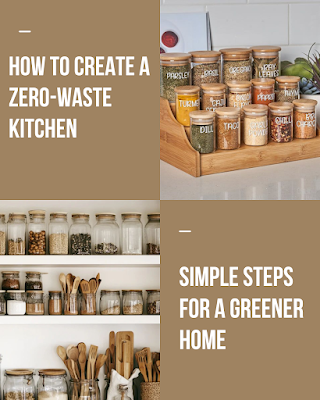How to Create a Zero-Waste Kitchen: Simple Steps for a Greener Home
How to Create a Zero-Waste Kitchen
Is your kitchen filled with plastic packaging, expired foods, and single-use items? You are not alone. But here is the good news: transforming your kitchen into a zero-waste zone is easier and more rewarding than you might think.
In this guide, we will explore how to create a zero-waste kitchen step-by-step, from choosing reusable tools to managing food scraps responsibly. Whether you are just starting your sustainability journey or looking to fine-tune your eco-habits, this article has something for you.
What Is a Zero-Waste Kitchen?
 |
| A Well Arranged Kitchen |
A zero-waste kitchen is a space designed to minimize waste and maximize sustainability. It focuses on reducing landfill contributions by eliminating single-use products, rethinking storage, and reusing or composting food waste. The goal is to create a circular system where nothing is wasted and everything is reused or recycled.
Why Aim for a Zero-Waste Kitchen?
Adopting a zero-waste kitchen isn’t just about saving the planet, it has personal benefits too:
-
Lower grocery bills through smarter shopping and reduced waste
-
Healthier eating habits due to fewer processed and packaged foods
-
Clutter-free spaces with intentional design and organization
-
Environmental impact reduction through less plastic and food waste
Steps to Create a Zero-Waste Kitchen
1. Take Stock and Declutter
Start by assessing what you already have. Go through your drawers, cabinets, and pantry:
-
Donate or repurpose items you rarely use.
-
Consolidate duplicate tools.
-
Properly dispose of expired goods and plastic packaging.
This sets the foundation for a clean, minimalist kitchen where everything has a purpose.
Read Also: Upcycling & Thrifting: How to Give Old Clothes a New Life
2. Switch to Reusable Kitchen Essentials
One of the most effective steps is to replace disposables with reusables. Here are some easy swaps you can start with:
-
Instead of paper towels, use cloth rags or unpaper towels.
-
Instead of plastic wrap, try beeswax wraps or silicone stretch lids.
-
Instead of plastic containers, opt for glass or stainless steel containers.
-
Instead of plastic bags, use reusable produce bags or cloth pouches.
-
Instead of coffee pods, switch to refillable pods, a French press, or a pour-over setup.
 |
| Reusable Kitchen Item |
3. Buy in Bulk and Reduce Packaging
Opt for bulk bins and package-free sections when grocery shopping. Bring your own jars or cloth bags for:
-
Grains, pasta, and rice
-
Spices and herbs
-
Dried fruit, nuts, and legumes
Buying in bulk not only reduces plastic waste but also saves money over time.
4. Store Food Smartly to Prevent Waste
Improper storage leads to food spoilage, which is one of the top contributors to kitchen waste. Try these tips:
-
Use clear containers so you can see what’s inside.
-
Label leftovers with dates.
-
Organize your fridge using the FIFO method (First In, First Out).
-
Keep leafy greens fresh in cloth bags or damp towels.
Smart storage = less waste and more savings.
 |
| A Well Organized Fridge |
5. Compost Food Scraps
Not everything can be eaten, but that doesn’t mean it should be trashed. Start a compost system for:
-
Fruit and vegetable peels
-
Coffee grounds and tea bags (non-plastic)
-
Eggshells
-
Grains and bread (in moderation)
You can compost at home with a bin, vermicomposting system, or even community drop-off programs.
6. Plan Meals to Minimize Waste
Meal planning is a powerful zero-waste strategy. It helps you:
-
Buy only what you need
-
Use up leftovers creatively
-
Avoid impulse purchases
Try these techniques:
-
Make a weekly meal plan and shopping list
-
Have a “clean-out-the-fridge” night once a week
7. Embrace DIY and Homemade Staples
Instead of buying processed or packaged goods, make simple staples at home:
-
Homemade broth from veggie scraps
-
Nut milk in reusable bottles
-
Granola, energy bars, and sauces
-
Cleaning products with vinegar and essential oils
DIY options are healthier, customizable, and reduce packaging waste.
8. Set Up a Zero-Waste Station
Designate a space in your kitchen for your zero-waste tools. This might include:
-
Jars and containers for bulk goods
-
A compost bin or pail
-
Reusable produce bags and wraps
-
Labels and a marker for organizing
This makes your zero-waste journey visible, easy, and motivating.
Read Also: 10 Eco-Friendly Swaps for a More Sustainable Lifesytle.
Conclusion: Start Small, Stay Consistent
Creating a zero-waste kitchen does not happen overnight. It is a journey, not a destination. Start with one change at a time; swap paper towels for cloth, plan meals for the week, or begin composting your scraps.
Small actions, when repeated daily, lead to big environmental impacts. And in the process, you will enjoy a cleaner, simpler, and more intentional kitchen space.
💚 Ready to Start Your Zero-Waste Journey?
Grab a cloth bag, clear a shelf, or try a new recipe using what is in your fridge. Your sustainable kitchen starts today.



Comments
Post a Comment